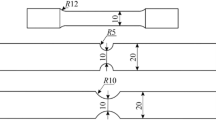Abstract
Mathematical models and algorithms were developed for determining the effective angle of separation and specific adhesive energy for rigid fibres separated from a cylindrical body (pack). The results of the studies confirm the necessity of using the effective angle of separation in calculating the fibre bending rigidity profile in the region of separation from the pack and the energy characteristics, which allows significantly reducing the error of test results.
Similar content being viewed by others
References
V. I. Kiselev, Development of a Theory of Surface Phenomena and Methods of Assessing Their Correlation with the Properties and Prediction of the Quality of Glass Fibres, Doctoral Dissertation, Moscow Textile Institute, Moscow (1991).
A. A. Berlin and V. E. Basin, Principles of Adhesion of Polyemrs [in Russian], Khimiya, Moscow (1974).
E. P. Popov, Theory and Calculation of Rigid Elastic Rods [in Russian], Nauka, Moscow (1986).
T. I. Andreeva, V. I. Kiselev, and A. I. Koblyakov, Khim. Volokna, No. 1, 44–46 (1994).
Additional information
Stekloplastik—Sertifikat Corp., Moscow. Translated from Khimicheskie Volokna, No. 3, pp. 49–52, May–June, 1995.
Rights and permissions
About this article
Cite this article
Kiselev, V.I., Rudenko, T.D. & Ivanov, D.G. Evaluation of the interlayer adhesive reaction of rigid fibres in peeling from the pack. Fibre Chem 27, 193–197 (1996). https://doi.org/10.1007/BF00554582
Issue Date:
DOI: https://doi.org/10.1007/BF00554582




